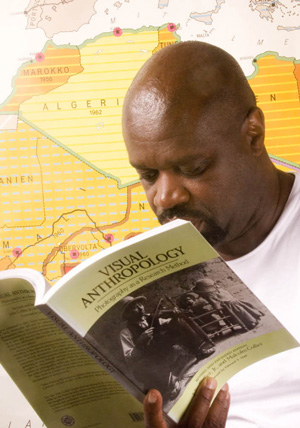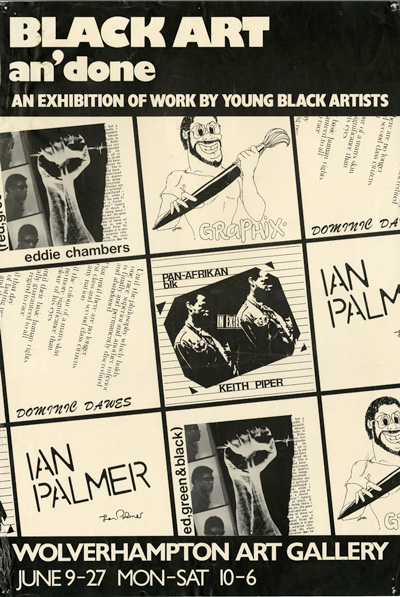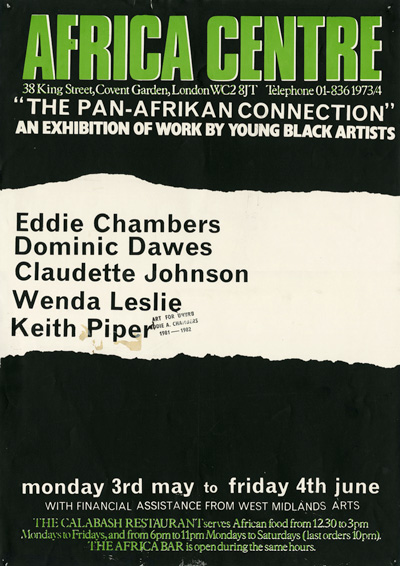 |
|||
Keith Piper is a Black British artist, curator, researcher and academic.
His creative practice responds to specific issues, historical relationships and geographical sites. He has exhibited work national and internationally.
In the early 1980s, Piper was a founder member of the ‘Blk Art Group’ an association of young artists of African Caribbean descent, based in the West Midlands.
During this period, he established a research driven approach to art practice, prioritising thematic exploration over an attachment to any particular media. His work has ranged from painting, through photography and installation to a use of digital media, video and computer-based interactivity.
Piper currently teaches Fine Art at Middlesex University, London.
|
Piper’s parents were members of what has come to be known as the ‘Windrush Generation’, travelling to the UK from the Caribbean during the 1950s in the wake of the pioneering voyage of the ‘Empire Windrush’ in 1948.
In common with a small, but significant number of young people from this generation, Piper’s father opted for ‘National Service’, as a potential route to advancement. Joining the Royal Air Force as a medic, Piper’s father was posted to Malta in 1959 with his young family. Piper was born in the David Bruce Royal Naval Hospital in Mtarfa, Malta in 1960.
Returning to the Sparkbrook/Balsall Heath/Small Heath area of Birmingham, England in 1961, Pipers family were to join an evolving community where migrants from Ireland, the Indian subcontinent, the Caribbean and Africa, mingled and contested space with the indigenous white working-class communities of inner-city south Birmingham. The ‘second generation’ children of these migrant communities grew up and were schooled within a British context in which at times, racist ideologies, practices and attitudes derived from the ‘undead’ legacies of a rapidly fading empire were still enacted.
Although challenged by successive waves of political activism, this racism, by the mid 1970s was still largely intact and being sharpened by economic decline. The first waves of British educated young black people began to emerge from the school system into a 1970s landscape in which structural unemployment, an aggressively racist police force and a surge in neo-fascist activity combined to make the newly emerging status of 'Black Britishness' feel all too precarious.
The resultant radicalisation of this generation took a number of forms. The most dramatic found expression in the anti-police 'uprisings' that punctuated the period between the historic events at the Notting Hill Carnival in 1976, the spate of 'riots' which ignited nationwide in 1981, and the uprisings sparked in response to the shooting of Cherry Groce in Brixton and the death of Cynthia Jarrett in Tottenham in 1985.
This history is explored in greater depth in Pipers digital paper 'Pathways to the 1980s', first presented at the Blk Art Group Symposium, Sheffield in Feb 2012 and at the Blk Art Group Research Project conference ‘Reframing the Moment' in October 2012.
In common with many young people of Caribbean descent, Piper’s home context was marked by an adherence to the Christian fundamentalism bought by migrant parents from their islands of origin. As with many young people of this generation, Piper underwent a rebellion against what could be seen as the structural conservatism that this background often enforced
However, as in all cases, the moment and mode of this rebellion is key. During the summer of 1976, which ended with riot on the streets of Notting Hill, Piper was busy studying for his O-Level exams. At the moment of Margaret Thatcher's notorious 'swamping speech' of 1978 and her accession to power in 1979, Piper was in the middle of A-Level study. Although these events were at times referenced in Pipers teenage art practice, it was only in late 1979 when he first joined the Foundation Course in Art and Design at Lanchester Polytechnic in Coventry that a more emphatically politicised practice began to emerge.
It was at Lanchester Polytechnic that Piper first met a young artist from Wolverhampton called Eddie Chambers. Like Piper, Chambers was a product of the rigorously literal, conservative and fundamentalist Seventh Day Adventist Church. Like Piper, Chambers had spent the latter part of his teenage years listening to the lyrics of radicalised Reggae music and reading the writings of Black American political figures in search of new certainties. Unlike Piper however, Chambers was already converting interests into positive action, bringing together a small group of artist friends from the Wolverhampton region, aided by the mentorship of local activist Eric Pembleton. He was already working towards an exhibition by what was then called the 'Wolverhampton Young Black Artists Group'. This exhibition would eventually be held in Wolverhampton Art Gallery in June 1981 under the title "Black Art an' done". The line-up of artists in the show included Chambers, Dominic Dawes, Ian Palmer, Andrew Hazel and Piper.
The period from 1981 to 1984 saw the 'Wolverhampton Young Black Artist Group' re-named as the 'BLK Art Group', and a series of exhibitions mounted around the UK under the title of 'The Pan-Afrikan Connection'. During this period the line-up of artists would also evolve. Claudette Johnson, an art student studying at The Polytechnic Wolverhampton joined the group before the second show at the Africa Centre in Covent Garden in 1982.
In 1980, following the one-year foundation course in Coventry, Chambers went to study Fine Art at Sunderland Polytechnic and Piper went to Trent Polytechnic in Nottingham. In the following year, Donald Rodney another young artist from the West Midlands, in this case Smethwick, joined the Fine Art course at Trent Polytechnic Nottingham. He was introduced to Chambers by Piper and became involved in the Group’s activities. In 1982, during a group exhibition at The Ikon Gallery another young Birmingham based artist, Marlene Smith introduced herself and became an active member.
A personal account of the formation and history of the Blk Art Group can be seen in the video essay by Piper, ‘Coming up in the Black Moment’, which is also an embedded segment within the video essay ‘Pathways to the 1980s’ (2012).
|
|


